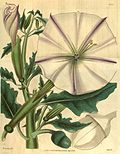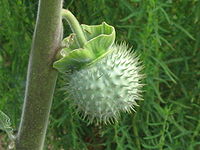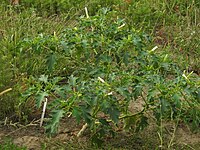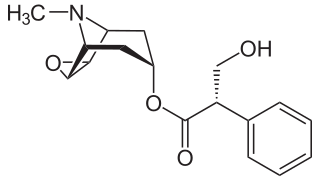
Scopolamine, also known as hyoscine, or Devil's Breath, is a natural or synthetically produced tropane alkaloid and anticholinergic drug that is used as a medication to treat motion sickness and postoperative nausea and vomiting. It is also sometimes used before surgery to decrease saliva. When used by injection, effects begin after about 20 minutes and last for up to 8 hours. It may also be used orally and as a transdermal patch since it has been long known to have transdermal bioavailability.
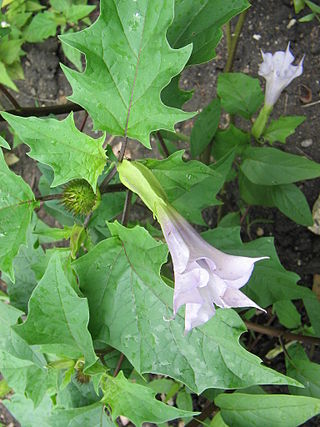
Datura stramonium, known by the common names thorn apple, jimsonweed, devil's snare, or devil's trumpet, is a poisonous flowering plant of the nightshade family Solanaceae. It is a species belonging to the Datura genus and Daturae tribe. Its likely origin was in Central America, and it has been introduced in many world regions. It is an aggressive invasive weed in temperate climates and tropical climates across the world. D. stramonium has frequently been employed in traditional medicine to treat a variety of ailments. It has also been used as a hallucinogen, taken entheogenically to cause intense, sacred or occult visions. It is unlikely ever to become a major drug of abuse owing to effects upon both mind and body frequently perceived as being highly unpleasant, giving rise to a state of profound and long-lasting disorientation or delirium with a potentially fatal outcome. It contains tropane alkaloids which are responsible for the psychoactive effects, and may be severely toxic.

Atropa belladonna, commonly known as belladonna or deadly nightshade, is a toxic perennial herbaceous plant in the nightshade family Solanaceae, which also includes tomatoes, potatoes and aubergine (eggplant). It is native to Europe and Western Asia, including Turkey. Its distribution extends from Ireland in the west to western Ukraine and the Iranian province of Gilan in the east. It is also naturalised or introduced in some parts of Canada, North Africa and the United States.

Hyoscyamine is a naturally occurring tropane alkaloid and plant toxin. It is a secondary metabolite found in certain plants of the family Solanaceae, including henbane, mandrake, angel's trumpets, jimsonweed, the sorcerers' tree, and Atropa belladonna. It is the levorotary isomer of atropine and thus sometimes known as levo-atropine.

Datura wrightii, commonly known as sacred datura, is a poisonous perennial plant species and ornamental flower of the family Solanaceae native to the Southwestern United States and northwestern Mexico. It is sometimes used as a hallucinogen due to its psychoactive alkaloids. D. wrightii is classified as an anticholinergic deliriant.

Brugmansia is a genus of seven species of flowering plants in the nightshade family Solanaceae. They are woody trees or shrubs, with pendulous flowers, and have no spines on their fruit. Their large, fragrant flowers give them their common name of angel's trumpets, adjacent to the nickname devil's trumpets of the closely related genus Datura.

Henbane is a poisonous plant in the nightshade family Solanaceae. Henbane is native to temperate Europe and Siberia, and naturalised in Great Britain and Ireland.
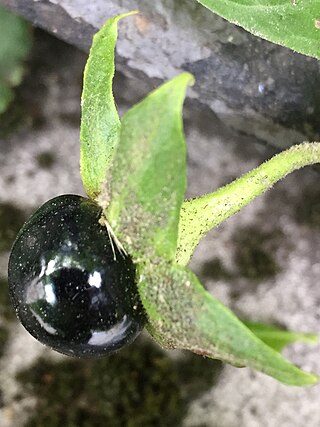
Deliriants are a subclass of hallucinogen. The term was coined in the early 1980s to distinguish these drugs from psychedelics such as LSD and dissociatives such as ketamine, due to their primary effect of causing delirium, as opposed to the more lucid and less disturbed states produced by other types of hallucinogens. The term generally refers to anticholinergic drugs, which are substances that inhibit the function of the neurotransmitter acetylcholine. Common examples of deliriants include plants of the genera Datura and Brugmansia as well as higher than recommended dosages of diphenhydramine (Benadryl). A number of plant deliriants such as that of the Solanaceae family, particularly in the Americas have been used by some indigenous cultures to reach delirious and altered states for traditions or rituals, such as rites of passage, divination or communicating with the ancestors. Despite their long history of use, deliriants are the least-studied class of hallucinogens in terms of their behavioral and neurological effects.

Datura metel is a shrub-like annual or short-lived, shrubby perennial, commonly known in Europe as Indian thornapple, Hindu Datura, or metel and in the United States as devil's trumpet or angel's trumpet. Datura metel is naturalised in all the warmer countries of the world. It is found notably in India, where it is known by the ancient, Sanskrit-derived, Hindi name dhatūra (धतूरा), from which the genus name Datura is derived.

The ancient Aztecs employed a variety of entheogenic plants and animals within their society. The various species have been identified through their depiction on murals, vases, and other objects.

Datura innoxia, known as pricklyburr, recurved thorn-apple, downy thorn-apple, Indian-apple, lovache, moonflower, nacazcul, toloatzin, toloaxihuitl, tolguache or toloache, is a species of flowering plant in the family Solanaceae. It is more rarely called sacred datura, a common name which is applied more often to the closely related Datura wrightii. It is native to the Southwestern United States, Central and South America, and introduced in Africa, Asia, Australia and Europe. The scientific name is often cited as D. innoxia. When English botanist Philip Miller first described the species in 1768, he misspelled the Latin word innoxia (inoffensive) when naming it D. inoxia. The name Datura meteloides was for some time erroneously applied to some members of the species, but that name has now been abandoned.
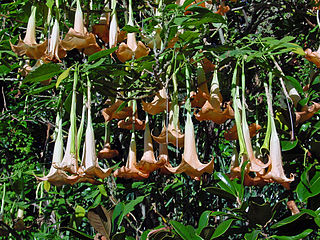
Brugmansia versicolor is a species of plant in the family Solanaceae, commonly known as “angel’s trumpets”. They are endemic to Ecuador. Since March 2014, they have been listed as Extinct in the Wild by the IUCN.

Brugmansia suaveolens, Brazil's white angel trumpet, also known as angel's tears and snowy angel's trumpet, is a species of flowering plant in the nightshade family Solanaceae, native to south eastern Brazil, but thought to be extinct in the wild. Like several other species of Brugmansia, it exists as an introduced species in areas outside its native range. It is a tender shrub or small tree with large semi-evergreen leaves and fragrant yellow or white trumpet-shaped flowers.

Tropane alkaloids are a class of bicyclic [3.2.1] alkaloids and secondary metabolites that contain a tropane ring in their chemical structure. Tropane alkaloids occur naturally in many members of the plant family Solanaceae. Certain tropane alkaloids such as cocaine and scopolamine are notorious for their psychoactive effects, related usage and cultural associations. Particular tropane alkaloids such as these have pharmacological properties and can act as anticholinergics or stimulants.

Anisodamine, also known as 7β-hydroxyhyoscyamine, is an anticholinergic and α1 adrenergic receptor antagonist used in the treatment of acute circulatory shock in China. It is given orally or by injection, as a racemic mixture (racanisodamine) or as a hydrobromide salt. Eye drops at 0.5% concentration for slowing the progression of myopia is also available in China.

Brugmansia sanguinea, the red angel's trumpet, is a species of South American flowering shrub or small tree belonging to the genus Brugmansia in tribe Datureae of subfamily Solanoideae of the nightshade family Solanaceae. It has been cultivated and used as an entheogen for shamanic purposes by the South American Natives for centuries - possibly even millennia.

Meteloidine is an alkaloid found in some Brugmansia and Datura species. Its also found in Erythroxylum australe and is said to be cocaine-like alkaloid.

Mandragora is a plant genus belonging to the nightshade family (Solanaceae). Members of the genus are known as mandrakes. Between three and five species are placed in the genus. The one or two species found around the Mediterranean constitute the mandrake of ancient writers such as Dioscorides. Two or three further species are found eastwards into China. All are perennial herbaceous plants, with large tap roots and leaves in the form of a rosette. Individual flowers are bell-shaped, whitish through to violet, and followed by yellow or orange berries.

The Solanaceae, or the nightshades, are a family of flowering plants that ranges from annual and perennial herbs to vines, lianas, epiphytes, shrubs, and trees, and includes a number of agricultural crops, medicinal plants, spices, weeds, and ornamentals. Many members of the family contain potent alkaloids, and some are highly toxic, but many—including tomatoes, potatoes, eggplant, bell and chili peppers—are used as food. The family belongs to the order Solanales, in the asterid group and class Magnoliopsida (dicotyledons). The Solanaceae consists of about 98 genera and some 2,700 species, with a great diversity of habitats, morphology and ecology.
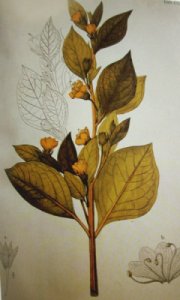
Atropa baetica, commonly known as the Andalusian belladonna, is one of Europe's rarest wildflowers. A close relative of the infamous deadly nightshade, its specific name derives from that of the Roman province of Hispania Baetica, while its common name refers to the Spanish region of Andalucía – both designating the area in the south of Spain where it is most frequently encountered. It is an attractive perennial plant with a herbaceous habit, bearing infundibuliform, yellow or greenish flowers and shiny, black berries. Like the other three species of Atropa, it is an extremely poisonous plant, containing a variety of tropane alkaloids with anticholinergic, deliriant, antispasmodic and mydriatic properties. Although most populations of the plant are to be found in Spain, it is not wholly confined to the Iberian Peninsula of Europe, occurring also in certain localities in Morocco and Algeria in the Atlas Mountains of North Africa. The Rif and the Baetic System, which face each other across the Alboran Sea, together constitute one of the finest of the Mediterranean biodiversity hotspots – rich in endemic species, of which Atropa baetica is a notable example..


